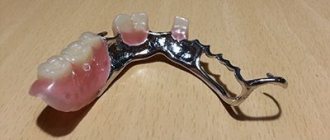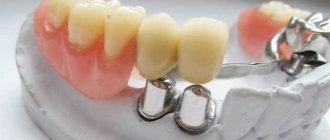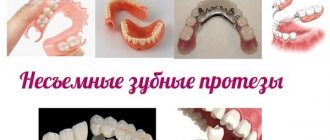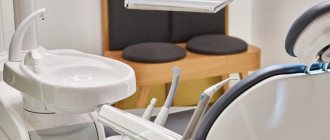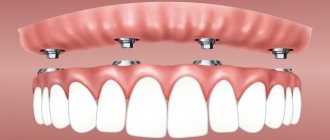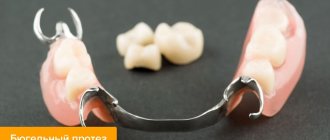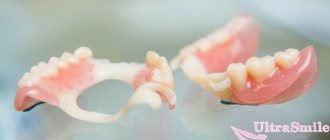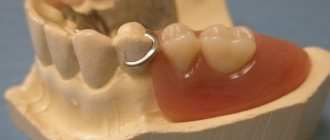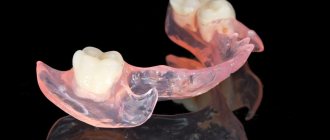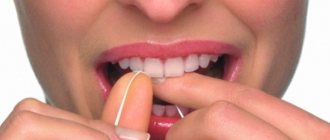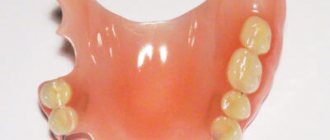Home → Articles → Technique for making a clasp prosthesis
Clasp denture is a removable device that compensates for partial tooth loss. Its main distinguishing feature is the presence of an arched metal frame. Due to the original design, the use of the device is characterized by convenience.
The technique of clasp prosthetics is a painstaking process that takes a lot of time. It consists of two stages: clinical, laboratory. Each device is created in a dental clinic according to personal casts of the jaws.
Sign up for a consultation at the dental clinic “Stomatolog11” in the Northern Administrative District:
Make an appointment
Types and advantages of clasp dentures
In modern dentistry, prostheses are widely used, the distinctive feature of which is the presence of micro-locking fasteners, clasps, with a telescopic fixation mechanism.
The clasp design is a solid cast arch with a base (plastic base) and artificial teeth located on it.
This prosthetics is used in situations where, for a number of reasons, it is not possible to install implants.
The advantages of using these models are:
- ease of use, thanks to a thin arc, reliable fixation, the adaptation process is much faster; it does not change speech, does not reset, and allows you to completely restore chewing functions;
- durability is achieved due to the small, especially in comparison with other types of removable dentures, load on the gums and bone tissue, which slows down the atrophy process and allows you to wear the system for a longer period of time without changing the denture;
- dentures can be removed only for hygienic care, leaving them on overnight;
- strength, which is associated with the use of a solid cast arc, which minimizes the risk of system failure;
- aesthetic appearance, especially in terms of the ability to restore the aesthetics of teeth when choosing dentures with locking fastenings, or those that are fixed using telescopic crowns;
- splinting dentures allow you to combine dental restoration with the treatment of periodontal disease.
As you can see, there are enough advantages, but one cannot fail to mention the existing disadvantages:
- high price;
- decrease in elasticity when fastening with clasps;
- The complete absence of teeth does not allow the installation of structures; there must be at least four supporting teeth.
There are also certain indications and prohibitions for installing such systems, which experts will tell you about in relation to each specific case.
Materials used in the manufacture of clasp dentures
Currently, clasp dentures are made on fire-resistant models. In the case where soldering is necessary, laser or hydrogen soldering is chosen. Thanks to this, local heating is ensured, which does not allow changes in the properties of the alloys used and is usually used to securely fasten the fixing elements.
If it is necessary to make prostheses with removal from the model or one-sided ones of short length, preference is given to special types of modeling plastic, which makes it possible to almost completely eliminate deformation of the entire structure during the work.
In full accordance with the materials from which clasp dentures are made, the cost of the finished product, indicators of strength, convenience and period of use are added up.
Today, the following materials are chosen for such structures:
1. Metal-free or quadrotti prosthesis. The arc in them is made from durable types of pressed plastic and ceramics. An ideal option for those patients who have an allergic reaction to metals.
The disadvantages are:
- fragility of the structure;
- short period of use;
- high risk of various types of damage to the prosthesis.
2. Clasps, the arc of which is made of chromium-cobalt alloys. They are distinguished by high reliability indicators due to the solid metal frame. The arch of the prosthesis with locking fixation includes metal-ceramic crowns.
3. A worthy alternative to designs with chromium-cobalt alloys can be gold-platinum alloys, the most expensive, but not causing allergic reactions. They are used to make arches and caps for metal-ceramic crowns.
As you can see, you can choose prostheses in full accordance with the wishes of the patient.
Locking clasp dentures
Clasp prosthetics is one of the types of removable dental prosthetics.
Clasp dentures are characterized by the presence of micro-lock fastenings, which increase the strength and reliability of the entire structure. During dental prosthetics, locks are attached to healthy supporting teeth. Another option for support can be crowns prepared in a special way.
After prosthetics, the locks through which the teeth are secured remain completely invisible. In the same way, you can reliably disguise metal elements.
Thanks to this technology, it is possible to achieve high aesthetic appearance indicators.
Two types of fastening of clasp structures have been developed:
1.With clasps or hooks.
2. With locks - attachments.
It is the latter that have gained the greatest popularity, being subdivided in turn into rotary, hinged, and rigid. Their choice depends on how the defects are located in the dentition.
Features of the structure of locks in clasp dentures:
- connection of the matrix with the clasp structure;
- The lock matrix is attached to the abutment tooth or to an artificial crown.
To close the lock, you must insert one of its parts into the other to achieve a strong fixation. Locks have been developed that are attached to tooth enamel using composites. However, this option cannot be considered truly reliable; accordingly, this mount is short-lived.
It is impossible not to note the great aesthetic appeal of clasp dentures with locking fastenings when compared with designs that use clasps.
This circumstance is due to the absence of metal hooks on the front of the teeth. This design is attached directly to the teeth or crowns.
To protect the supporting teeth, when using bridges, crowns with locks are placed on them. With their help, you can later remove such prostheses in order to carry out hygienic treatment or repair them if necessary.
The advantages of clasp dentures with locking retainers when compared with other types of dentures:
- lightweight biocompatible materials are used in the manufacture of the frame;
- ease of care;
- there is no even minor discomfort during use;
- no problems with diction;
- the load on the jaws is evenly distributed;
- high levels of aesthetics;
- Compact, highly durable design.
However, when choosing these models, you should be aware of the disadvantages that are characteristic of them:
- high cost of clasp locking prostheses, even in comparison with clasp structures;
- the need to replace plastic locks every two years;
- impossibility of repairing some types of locks;
- Preparation for the installation of locks requires preparatory work in the form of grinding of teeth and their depulpation.
List of indications for installation
There are certain indications when it is absolutely necessary to install clasp locking dentures:
- if teeth are partially missing;
- terminal and included defects of the dentition;
- impaired chewing function, diction due to the absence of several teeth;
- not aesthetic;
- increased abrasion of tooth enamel;
- carrying out splinting for periodontal disease;
- if it is not possible to use a plate prosthesis for atrophy of the alveolar processes;
- pronounced tubercles of the upper jaw;
- flat palate;
- diabetes;
- blood diseases, in which there is a decrease in the resistance of capillaries located on the gum mucosa;
- it is impossible to install a permanent structure;
- teeth grinding (bruxism);
- malocclusion.
There are a number of contraindications to the use of locking structures:
- in the presence of defects in the tissues of supporting teeth and periodontal damage;
- low placement of dental crowns;
- small size of the lingual-buccal space, which makes it difficult to place locks on the incisors and canines.
When choosing a removable denture, it is necessary to take into account all the existing advantages and disadvantages of this design. When choosing a design and method of fixation, you should proceed from the recommended indications. The general condition of the dental system is of great importance.
Answers to the questions that patients usually have will help you make your choice.
- 1. You should perform the necessary hygiene procedures while removing clasp dentures in the morning and before bed.
- 2. The service life of the lock structure is 5 years or more, which depends on how correctly they are used.
- 3. There is no need to grind the supporting teeth for crowns if they are completely healthy, as well as installing the crowns themselves when choosing a clasp system.
- 4.The use of a clasp denture ensures uniform distribution of pressure between the jaw bones and supporting teeth, which prevents loosening of the teeth. Moreover, in some cases, clasps can be prescribed as a remedy when teeth begin to become loose.
- 5. The main requirement when installing this design is that there are supporting teeth on which the prosthesis will be fixed. Their absence precludes its use.
- 6. In order to carry out high-quality cleaning of clasp structures, there is no need to use any special means. A regular toothbrush and toothpaste are sufficient. Moreover, it is absolutely not necessary to remove the entire structure at night.
If we talk about the cost of clasp dentures with locks, then even their high price cannot outweigh the advantages that they have.
They remain the most popular when choosing removable structures.
Rules for caring for artificial teeth
In order for the splinting clasp device to serve for a long time and maintain its aesthetic appearance, it is important to properly care for it. You can minimize the risk of frequent breakdowns if you follow simple rules:
Clean the device twice a day with a brush and paste that does not contain large abrasive particles;- rinse your mouth after each meal with warm water or an antibacterial dental rinse;
- clean the system every evening with a special solution;
- Avoid eating too hard foods and never chew on foreign hard objects;
- Visit the dentist twice a year so that he can assess the condition of the prosthesis and correct its location in the oral cavity.
If your denture fails, you should not attempt to repair it yourself. The most reasonable decision in such a situation is to contact your doctor. He will examine the breakdown and, if it can be corrected, will transfer the device to a dental technician. If it turns out that the device needs to be replaced with a new one, he will take care of this issue.
Clasp clasp dentures
Dental prosthetics does not lose its relevance. By choosing clasp clasp dentures, the patient regains the ability to chew food normally; they are practically indistinguishable from real teeth, which improves the overall aesthetics.
The design of the clasps consists of hooks through which the prosthesis is secured in the patient’s mouth. To make clasps, metal alloys are used, and the structure itself is used both for fixation and for performing support functions.
Types of clasp clasps
Along with fixing dentures, clasps help distribute the load on the gums and supporting teeth. Metal hooks are attached without preliminary turning, directly at the dental neck.
The design of the clasp consists of three elements:
- 1. Arcs.
- 2. The base on which the artificial teeth are located.
- 3.Fixing clasps.
There are several options for making clasp fastenings:
- sagging of the retaining clasps when chewing food; as a result, the load is transferred to the gums and oral tissues;
- Support clasps are characterized by a redistribution of the load on their teeth, which are used as support teeth; the load is partially distributed over the soft tissues of the oral cavity;
- The most popular are support-retaining clasps; the hook in its fixed part is located in the upper part of the tooth; clasp shoulders are placed on the front and back sides of each of the supporting teeth; the presence of a special lining prevents the formation of excessive pressure from the clasp on the mucous membrane; the process is that part of the clasp that is connected to the base.
There are differences between clasps, according to their design, based on:
- shapes – round, flat, ribbon;
- fixation method - with one and two arms, made in the form of a ring;
- production technologies – cast, bent.
A clasp is a metal strip that tightly covers the tooth at its widest point. It becomes desirable to cover the supporting teeth under the clasp denture with artificial crowns of a solid cast or metal-ceramic type.
The fixing and supporting functions of the clasp help distribute the chewing load between the teeth and the mucous membrane itself. The ideal option for this distribution is 1:3.
The disadvantages of this type of design include low levels of external aesthetics, especially since you can see the metal parts of the clasp when a person smiles or talks.
Moreover, the risk of breakage of the solid-cast structure made together with the arc is minimal.
What to give preference to?
When it comes to choosing the most suitable design, it is worth considering in detail the following options:
- 1. Cast clasp prosthesis, which practically does not spring during use.
- 2. Bent, the production of which involves the use of special blanks. This type is one of the most reliable products. Removing and putting them on repeatedly does not affect the basic characteristics. Flexibility and springy properties allow them to be perfectly adapted to any characteristics of the mouth.
In case of high-quality selection of a suitable model, the prosthesis is almost invisible.
Among the disadvantages of bent clasps, it is worth noting that the service life completely depends on the quality of fixation of the hook underlying the prosthesis. Also, they cannot be installed when the angle of inclination of the main teeth is too large.
Design Features
Splinting structures have a number of features:
- the base , made of plastic or a combined material, is distinguished by its reduced size, which facilitates rapid adaptation to a foreign body in the mouth and comfortable wearing;
- according to the method of installation, the products are removable and non-removable (the former are easily put on and removed by the patient independently, and the latter are fixed for a long time, subject to constant wear for 2-6 months);
- according to production technology, structures are either solid-cast or soldered (in the first case, a non-separable frame is used, the second option involves stage-by-stage production with subsequent assembly);
- the base part does not come into contact with the palate, which eliminates distortion of speech or taste sensations;
- splinting products prevent bone tissue atrophy; while chewing food, the load is redirected to the entire jaw;
- products are highly durable;
- the design helps restore the anatomy of the dental system.
Splinting clasp dentures
If a patient is diagnosed with periodontal disease, doctors can offer him a splinting design to choose from. Its use helps reduce tooth mobility, helps restore chewing functions and attractive appearance. A distinctive feature of this design is an additional arch, which is placed on the inside of the prosthesis.
A splinting clasp is a removable structure used if the patient has mobility of the dentition (individual teeth).
The main purpose of clasp dentures with splinting elements:
- tending loose teeth;
- restoration of lost ones.
The design of a splinting clasp prosthesis is a metal arch containing clasps of many links, claw-shaped processes, rings that fix each of the moving teeth.
For the supporting teeth, on which the entire structure is attached, crowns are provided, which helps to evenly distribute the additional load when chewing food from those teeth that are loose to healthy and alveolar processes.
How effective the procedure for strengthening teeth will be depends on what stage the disease is at.
The splinting clasp design is determined individually for each patient. Much depends on factors such as age, type of bite, condition of mobile teeth, as well as the number of lost ones.
Indications for the use of clasp splinting prosthetics are:
- if at least three teeth are missing in the dentition and there is no support on one side;
- the presence of diseases of the tissues that surround the teeth, with bleeding gums;
- teeth are in the wrong position;
- bruxism and deep bite;
- defects in the dentition that caused tooth displacement;
- roots are exposed;
- Gum pockets are clearly visible.
Contraindications
The use of clasp splinting devices is contraindicated:
with unsatisfactory oral hygiene;- during pregnancy;
- for acute inflammatory lesions of the mucous membranes and gums;
- in the period after radiation therapy sessions;
- for oncology;
- for mental illness;
- for severe heart pathologies;
- with pronounced disturbances in the structure of bone tissue;
- with individual intolerance to metal;
- if the supporting teeth do not have the required height;
- in case of unsatisfactory condition of support units.
The doctor makes a decision on the possibility of prosthetics using a splinting clasp device after an in-person examination of the patient’s oral cavity and a series of diagnostic techniques.
Clasp acetal prosthesis (QUADROTTI)
Even the widespread introduction of modern methods of dental implantology does not reduce the popularity of removable prosthetics.
This circumstance is connected with the truly wide possibilities that open up when choosing prostheses. It is also impossible not to note the greater accessibility of such structures for the majority of patients who visit dental clinics.
Every year, new materials are developed and successfully introduced in the manufacture of prosthetics.
A distinctive feature of the obtained properties is a significant superiority in comparison with primary plastics, which are quite rigid and inconvenient to use.
Acetal is exactly such a material.
Orthopedic dentures, in the manufacture of which this material is used, have received undeniable advantages.
First of all, these are high aesthetic indicators. The inherent properties of the material open up wide possibilities for dentists, providing patients with greater comfort.
It became possible to achieve such amazing results thanks to the following unique properties of this chemical compound:
- high stability;
- resistance to mechanical damage, intense loads, abrasion;
- is not afraid of the negative influence of organic oils and solvents;
- easy to process.
The listed components may include complete safety of the material even for susceptible patients prone to allergic reactions.
The strength of clasp acetal dentures can be compared with metal ones, with greater efficiency due to elasticity and softness. All this provides a greater fit and a better degree of fixation.
A wide range of color compositions allows you to choose almost any shade.
Currently, the concept of “clasp acetal dentures” includes wide application possibilities:
- replacement of dental crowns;
- production of clasp dentures;
- clasps.
It is the last of the described options that are most often used in modern dentistry.
The clasp acetal prosthesis is a rather complex structure consisting of the following parts:
- frame, including arches and parts securing the structure in the oral cavity;
- bases are elements that imitate teeth.
The actual origin of the word “bugel” or arc has German roots, which explains the arched shapes of all structures.
The choice of such forms is quite understandable, since it allows the chewing load to be evenly distributed in the mouth. The latter circumstance is all the more important in order to maintain the periodontium of the jaw bones in normal condition.
Thanks to the clasp prosthesis, it is possible to partially restore the dentition; the arch-shaped form makes it possible to reduce the amount of artificial materials, which improves the process of adaptation.
For fastening, locking fasteners or attachments are used, installed on the patient’s supporting teeth.
The last of the elements listed above is of the lock or garnish type and consists of two parts that are inserted into each other:
- matrix, strengthened on the supporting teeth;
- patrix or the actual part of the prosthesis.
Until relatively recently, such structures consisted of a solid metal arc, providing strength for the entire structure.
The introduction of innovative technologies makes it possible today to use acetal in the manufacture of all parts, which has significantly reduced weight, increasing flexibility. At the same time, the method of fastening also changed. Initially, free space is left in the acetal arch for the teeth remaining in the mouth and special recesses are left to place the prosthesis on the supporting element.
When making clasp metal dentures with acetal clasps, the clasp itself has a normal appearance and design, which makes the base as strong as possible. Even the choice of acetal attachments does not affect the design characteristics of the clasp, since they allow for strong attachment to the base.
The advantages of the design include not only the properties of the material, but also the design itself:
- the area decreases, because the special shape of the prosthesis leaves most of the palate open;
- help preserve your own teeth;
- safety, with the complete absence of allergic reactions on the part of patients;
- strength, not inferior to metal ones;
- flexibility, ensures a tight fit to the palate and gums.
The listed properties facilitate the process of addiction, reducing the rehabilitation period.
This is a hygienic material that does not absorb pathogenic microflora developing in the oral cavity, leaves a comfortable feeling, and is easy to process.
Adds convenience and light weight since there are no metal parts.
There are no reasons for the appearance of galvanosis, a specific disease caused by galvanic currents arising in the mouth, if metal alloys are used in prosthetics.
The main symptoms include altered taste, metallic taste, and headache. Choosing acetal dentures allows you to avoid such unpleasant sensations.
The disadvantages of such prostheses include:
- small thickness in certain situations reduces the stabilizing properties of the prosthesis;
- difficulty in relocating the structure, especially since its cost is comparable to the price of a new prosthesis;
- the lack of shine of the artificial part sometimes disrupts the ideal appearance.
It is distinguished by the complexity of the technological process for manufacturing prostheses, with a remarkable final result. The affordable price is attractive, which opens up the possibility of choosing clasp acetal dentures (Quadrotti) for a wide range of the population.
Centrifugal casting
When centrifugal casting (Fig. 3) it is important that the poured alloy displaces the volume of air from the hollow mold of the flask as quickly as possible. Air is inevitably displaced through the pores of the corresponding investment material. When filling on the vibrating table, the investment material settles, i.e. large particles settle faster than small ones. Smaller particles form a dense layer on the surface of the flask, which, during centrifugal casting, slows down the displacement of air through the flask. In this case, it is recommended to grind the surface of the investment box with a trimmer to open the pores of the material.
When centrifugal casting, it is necessary to use a larger amount of alloy, since (Fig. 4) the centrifugal force exerts a sufficiently high pressure on the alloy, which allows it to be poured even into the thinnest parts of the flask (Fig. 5).
Rice. 3. Casting process using a centrifugal induction casting unit.
Rice. 4. Alloy in the crucible of a centrifugal casting installation.
Rice. 5. An object made of a noble alloy on a centrifugal installation.
